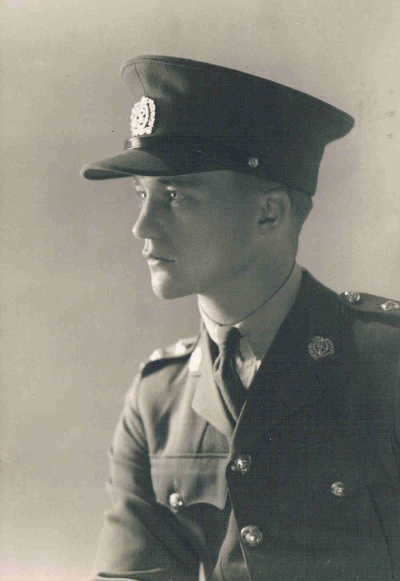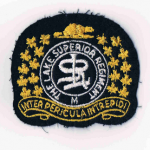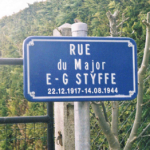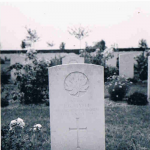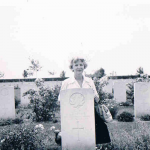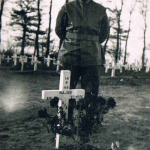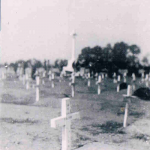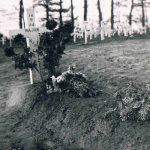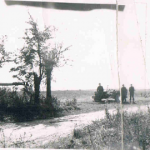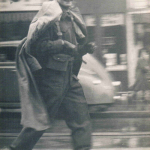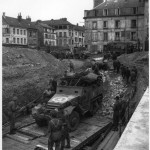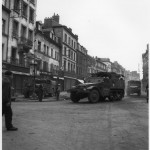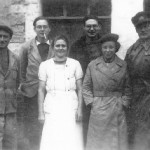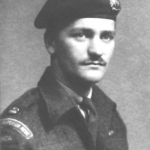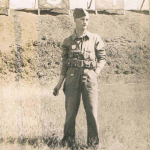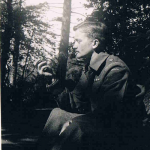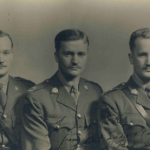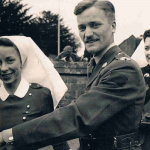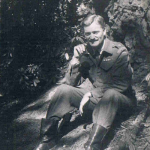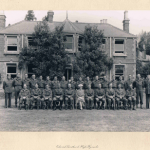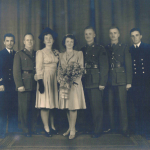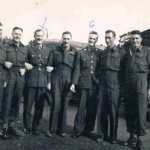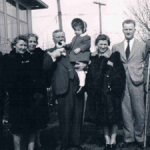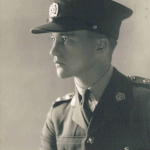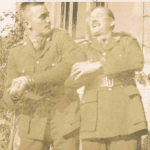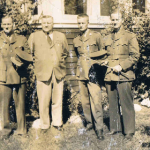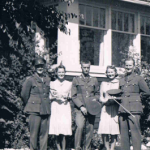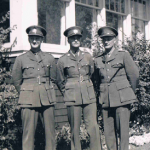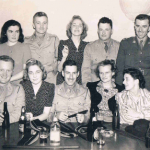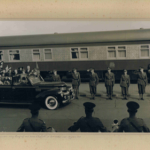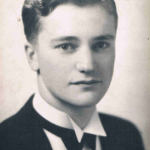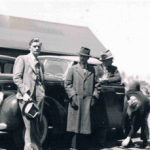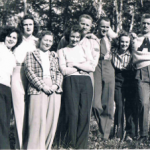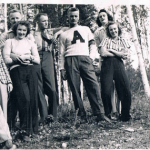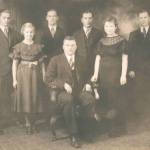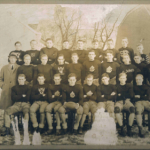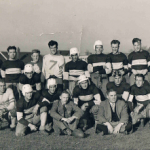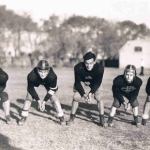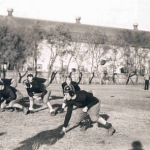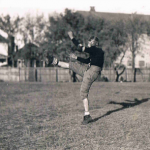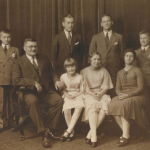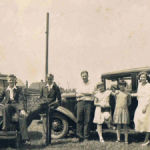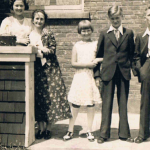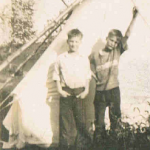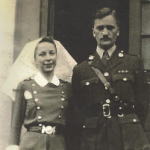The history
An expression of gratitude to Eddie and Mary
Edward Styffe was killed in a little village in Normandy while freeing the village from the Nazi occupation. Many years later the people of this same village honoured him by giving his name to its main street. It is one of many little stories which make up History. This is the story of a Canadian soldier killed in the battle for the liberation of Normandy in August 1944.
In 1999, in Maizières in Calvados, Normandy, the local council decided to name its streets officially. With only 450 inhabitants, Maizières had no official names for its streets like many other villages in France. However there were very old names for them in the Napoleonic records around 1812, beautifully set down in neat handwriting and coloured pencil and mostly long forgotten today. The council adopted some of these old names again which conjure up old world charm and times gone by
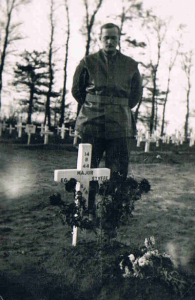
Brother Hobart at grave site
« le chemin de la jeune fille (Girl’s Path), la rue Berthe,(Bertha’s Street), le chemin de la croix St Nicolas (the path of St Nicolas’ cross), le chemin du bout à Capron(the top of Capron’s road), le chemin de la butte à Maurice (Maurice’s Hillpath), la rue de l’Ormelaie (Elmtree Glade Road)… »
The main street, CD 91 et 131, the road from Rouvres to Ernes needed a name.
In the Town Hall’s local information pamphlet, in Novembre 1999, «Maizières Info» n°3, the Mayor, Marc Alexis, invited the inhabitants of the village to participate in the choosing of a name for the main street. He wanted this name to be meaningful and connect with the village’s history past and future.
The names suggested were of mayors or personalities from the 60’s-80’s, but were considered as being perhaps too modern or with political connotations.
During a dinner for the senior citizens of the village in April 2000, there was talk of souvenirs and memories and the question was yet again raised :
“Who would you like the main street to be named after?”
Marcel Levernieux, deputy mayor, immediately spoke of a Canadian soldier who died in battle liberating the village. He recounted how he had been returning to the village after having been evacuated and how he and his brother Bernard had discovered a rough grave with a Canadian helmet on it and how they had decided to protect it from stray animals with planks of wood taken from his father’s baker’s shop which had been destroyed in the fighting.
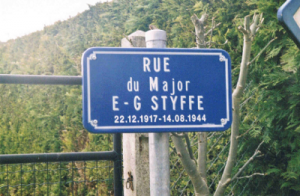
The street sign in Maizières
He was overcome with emotion, when he began to speak of what came later. One day in October 1944 he saw a jeep arriving with 3 Canadians in it ; it was this dead soldier’s driver, his brother and his wife, the family of this soldier who had been killed entering Maizières. They had come to see where he had died and to thank those who had taken care of his grave.
The Levernieux brothers took them round and spent time discussing what had happened. The driver took photos of them with their parents, the bakers.
Marcel Levernieux was 20 at the time, but whilst telling the story 55 years later, he was again overwhelmed by the distress of that woman he was meeting for the first time.
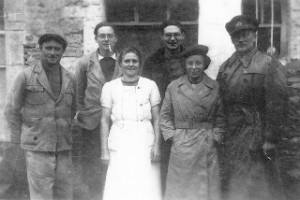
Mary à Maizières Septembre 1944
«She was just a little slip of a young woman, so slim and broken-hearted in her sadness and pain, and her brother in law who was trying to comfort her. She had been married to this soldier for only 3 months, she looked such a nice person and she was so sad ! Her name was Mary and her husband Edward Styffe.
The unknown soldier had a name and a family.
The local council gave the go-ahead to find out more about the name Edward Styffe put forward by Marcel Levernieux.
~ ~ ~
Comment dire merci à Eddie et Mary
C’est en libérant un petit village de Normandie que Edward Styffe est tué, c’est dans ce village que bien des années plus tard, son nom sera honoré par ses habitants…
C’est l’histoire d’une rencontre entre des petites histoires dans la grande Histoire, l’histoire retrouvée d’un soldat canadien mort à la libération de la Normandie en août 1944.
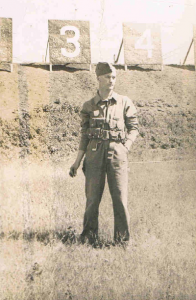
Eddie Styffe
En 1999, à Maizières dans le Calvados, en Normandie, le conseil municipal décide de nommer les rues de la commune pour répondre aux besoins des facteurs et des livreurs. Jusque là, avec ses 450 habitants, Maizières, comme beaucoup d’autres villages, n’avait pas de noms, sauf ceux très anciens du cadastre Napoléon – réalisé à la plume et aux crayons de couleurs aux alentours de 1812 – et oubliés depuis longtemps.
Le conseil municipal a repris ces anciens noms inscrits dans le cadastre avec, pour certains d’entre eux, un charme des temps passés comme le chemin de la jeune fille, la rue Berthe, le chemin de la croix Nicolas, le chemin du bout à Capron, le chemin de la butte à Maurice, la rue de l’Ormelaie…
Reste à nommer la rue principale CD 91 et 131, entre Rouvres et Ernes.
Dans le bulletin d’informations municipales de novembre 1999, «Maizières Info» n°3, le maire, Marc Alexis, invite les habitants du village à participer au choix d’un nom qui serait « l’occasion d’affirmer une identité locale modelée par l’histoire et ouverte sur l’avenir ».
Des noms de maires ou de personnalités des années 1960-1980 sont proposés mais le conseil préfère ne pas les retenir car ils sont encore trop contemporains, donc sujets à polémique possible. Il faut donc poursuivre la recherche.
Lors du repas des Anciens de la commune en avril 2000, une petite enquête est menée auprès des personnes présentes pour solliciter des souvenirs et répondre à la question : «Quel nom aimeriez-vous donner à la rue principale ?»
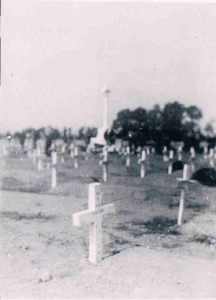
Grave site in Normandy
C’est Marcel Levernieux, adjoint au maire, qui va évoquer aussitôt un soldat canadien mort à la libération du village. Il raconte comment, à son retour de l’évacuation, il découvre avec son frère Bernard un monticule de terre avec un casque de l’armée canadienne posé dessus et comment ils décident de protéger cette sépulture des bêtes en divagation par des bouts de bois récupérés de la boulangerie de son père qui avait été bombardée. Puis c’est avec émotion qu’il se met à parler de cette journée d’octobre 1944 où il voit une jeep arriver avec trois Canadiens : le chauffeur, le frère et la femme du soldat abattu à l’entrée de Maizières. Ils venaient voir le lieu où il était mort et tenaient à remercier ceux qui avaient pris soin de sa tombe.
Les deux frères Levernieux les ont guidés et ils ont échangé ensemble… Le chauffeur les a pris en photo avec leurs parents.
Marcel avait 20 ans à l’époque mais en racontant ce souvenir 55 ans plus tard, il en est encore bouleversé par la douleur de cette femme qu’il rencontre pour la première fois : «Un petit bout de bonne femme, toute menue et brisée de chagrin, et son beau frère qui tentait en vain de la distraire de sa peine… Elle était mariée à ce soldat depuis seulement trois mois, elle avait l’air si gentille et elle était si triste ! Elle s’appelait Mary, et son mari Edward Styffe.»
Le soldat inconnu avait un nom et une famille.
- The Lake Superior Regiment Insignia
- Street sign in Maizières
- Grave site Canadian cemetry
- Sister Ingrid at grave site
- Brother Hobart at the grave site
- Grave site in Normandy
- The grave site, Normandy
- Area where Eddie was killed in Normandy
- Eddie
- Armoured crossing bridge Elbeuf 28 August, 1944
- LSR C company in Elbeuf 28 Aug 1944
- Mary and Major Hobart Styffe Maizières September 1944
- Major E G Styffe
- Eddie Styffe in the field
- Eddie enjoying a moment
- Brothers Hobart, Eddie and Roy
- Eddie with War Bride Mary Agnew
- Eddie enjoying a moment
- Military, England (Eddie far left)
- Marriage of brother Roy 2nd right St. John NB
- Edide 3 rd right with Br. Hobart 3 rd left
- Family photo; Eddie right with crutches
- Major Edward Grieg Styffe
- Playing with brother Hobart (left)
- Hobart, Oscar (father) Eddie and Roy
- Three brothers, Ingrid Center
- Three borthers
- Eddie at the back 2nd left Roy front left
- Visit of King George VI & Queen Elizabeth, Port Arthur, 3rd left
- Young Eddie
- Eddie left with brother John
- Friends (Eddie far right)
- Friends PA Br. Roy and Archie 3rd left
- Family Photo Far left
- School Football Team (Eddie 2nd left middle row)
- St. Johns School, Winnipeg Eddie Middle row behind brother Roy
- American football, 2nd from left
- School football
- Playing baseball
- Family photo (Eddie far left)
- Family (Eddie 2nd left)
- With Mother with sisters Ingrid and Ethel
- Youth Roy left and Eddie right
- Eddie & Mary in 1943

